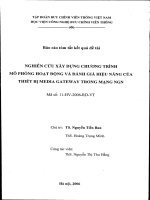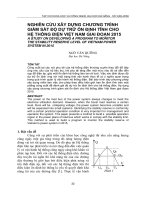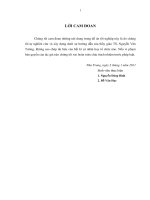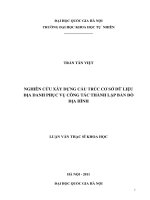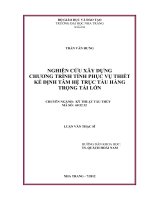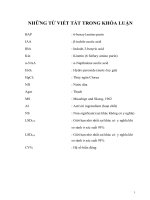Đề tài khoa học và công nghệ cấp Đại học Đà Nẵng Nghiên cứu xây dựng chương trình môn học Điện hóa học (Electrochemistry) phục vụ dạy học tăng cường tiếng Anh tại Đại học Đà Nẵng
Bạn đang xem bản rút gọn của tài liệu. Xem và tải ngay bản đầy đủ của tài liệu tại đây (606.62 KB, 24 trang )
BỘ GIÁO DỤC VÀ ĐÀO TẠO
§¹i häc ®µ n½ng
BÁO CÁO TÓM TẮT
ĐỀ TÀI KHOA HỌC VÀ CÔNG NGHỆ
CẤP ĐẠI HỌC ĐÀ NẴNG
NGHIÊN CỨU XÂY DỰNG CHƯƠNG TRÌNH MÔN HỌC ĐIỆN HÓA
HỌC (ELECTROCHEMISTRY) PHỤC VỤ DẠY HỌC TĂNG CƯỜNG
TIẾNG ANH TẠI ĐẠI HỌC ĐÀ NẴNG
Mã số: Đ2013-03-49-BS
Chủ nhiệm đề tài: PGS.TS. Lê Tự Hải
§µ N½ng, 11/2014
1
2
MỞ ĐẦU
1. TÍNH CẤP THIẾT CỦA ĐỀ TÀI
Điện hóa học là một bộ phận của Hóa lý, trong đó nghiên cứu những tính
chất vật lý của hệ ion, cũng như các quá trình và hiện tượng trên ranh giới phân
chia pha có sự tham gia của các phần tử tích điện (electron và ion). Bởi vậy, điện
hóa bao gồm tất cả các dạng tương tác giữa các phần tử tích điện linh động trong
các pha ngưng tụ ở trạng thái cân bằng, cũng như khi xảy ra phản ứng trên ranh
giới phân chia và trong lòng pha. Điện hóa được chia làm hai phần: Điện hóa học
lý thuyết và điện hóa học ứng dụng. Điện hóa học ứng dụng có liên quan đến nhiều
ngành khoa học khác như chế tạo nguồn điện hóa học (pin, ăc quy, pin nhiên liệu),
tổng hợp các hợp chất hữu cơ-vô cơ bằng phương pháp điện hóa, nghiên cứu ăn
mòn – bảo vệ kim loại, trong phân tích và xử lý môi trường, trong y – sinh, luyện
kim,… Như vậy, lĩnh vực nghiên cứu và ứng dụng của điện hóa rất rộng và có ảnh
hưởng đến nhiều ngành khoa học, công nghiệp khác nhau. Trong đào tạo, Điện hóa
học là môn học bắt buộc của các ngành đào tạo Cử nhân Hóa học, cũng như là một
môn học bắt buộc hay tự chọn của các ngành có liên quan (Công nghệ thực phẩm,
vật liệu, công nghệ hóa học,…).
Hiện nay, trong xu thế hội nhập với các nền khoa học tiên tiến của thế giới,
Đại học Đà Nẵng đẩy mạnh việc xây dựng các chương trình đào tạo theo hướng
tiếp cận trình độ đào tạo quốc tế với việc sử dụng phổ biến tiếng Anh trong dạy
học. Do vậy, việc nghiên cứu xây dựng chương trình môn học Điện hóa học
(Electrochemistry) theo hướng tăng cường tiếng Anh cho sinh viên là thực sự cần
thiết và cấp bách.
2. MỤC TIÊU ĐỀ TÀI
Xây dựng nội dung chương trình và biên soạn tài liệu môn học Điện hóa học
nhằm phục vụ dạy học tăng cường tiếng Anh tại Đại học Đà Nẵng.
3. ĐỐI TƯỢNG VÀ PHẠM VI NGHIÊN CỨU
3.1. Đối tượng nghiên cứu: Chương trình môn học Electrochemistry phục vụ dạy
học tăng cường tiếng Anh tại Đại học Đà Nẵng.
3.2. Phạm vi nghiên cứu: Chương trình môn học Electrochemistry xây dựng theo
hướng tích hợp, nội dung môn học được thể hiện bằng tiếng Anh. Nội dung
chương trình thuộc khối kiến thức đại cương, hướng đến phục vụ đa số sinh viên
Đại học Đà Nẵng. Hiện môn học này đang được giảng dạy tại các lớp Chương
trình tiên tiến Hóa dược, Cử nhân Hóa học thuộc trường ĐH Sư phạm – ĐHĐN.
3
4. NỘI DUNG NGHIÊN CỨU:
4.1. Nghiên cứu cơ sở lý luận về phát triển chương trình giáo dục/đào tạo
1.1. Khái niệm chương trình đào tạo
1.2. Các tiếp cận phát triển chương trình đào tạo
1.3. Các nội dung của phát triển chương trình đào tạo
1.4. Cấu trúc chương trình đào tạo
4.2. Xây dựng chương trình môn học Electrochemistry theo hướng tăng
cường tiếng Anh cho sinh viên Đại học Đà Nẵng
2.1. Phân tích nhu cầu
2.2. Xác định mục đích và mục tiêu đào tạo
2.3. Thiết kế chương trình
4.3. Thẩm định chương trình đào tạo đề xuất
3.1. Các phương pháp đánh giá chương trình đào tạo
3.2. Đánh giá của chuyên gia
4.4. Viết báo cáo và nghiệm thu đề tài
5. CÁCH TIẾP CẬN, PHƯƠNG PHÁP NGHIÊN CỨU
5.1. Cách tiếp cận: Tiếp cận tham khảo các chương trình môn học Electrochemistry
của một số trường Đại học thuộc các nước phát triển trên thế giới và chương trình
môn Điện hóa học của các trường Đại học trong nước.
5.2. Phương pháp nghiên cứu: Đề tài sử dụng các phương pháp: phân tích, tổng
hợp, phân loại và hệ thống hóa lý thuyết trong tất cả các khâu của thiết kế chương
trình đào tạo.
6. Ý NGHĨA KHOA HỌC VÀ THỰC TIỄN CỦA ĐỀ TÀI
Chương trình môn học về Điện hóa học (Electrochemistry) theo hướng tăng
cường tiếng Anh dành cho sinh viên và học viên Sau đại học của Đại học Đà Nẵng
được thiết kế, triển khai sử dụng, qua đó nâng cao chất lượng giáo dục đào tạo nói
chung của Đại học Đà Nẵng, đáp ứng yêu cầu đổi mới căn bản và toàn diện giáo
dục đại học Việt Nam.
Chương trình môn học Điện hóa học bằng tiếng Anh giúp cho sinh viên
ngành Hóa học nâng cao năng lực tiếng Anh, từ đó góp phần thực hiện chiến lược
quốc tế hóa của ngành GD&ĐT nói chung và ĐHĐN nói riêng.
4
ề cương chi tiết học phần
iện hóa học (ELECTROCHEMISTRY)
Số tín chỉ: 2 (2 TC lý thuyết)
Bộ môn: Hóa lý - Khoa Hóa
Mã số học phần:
Dạy cho các ngành: Cử nhân Sư phạm Hoá học, Cử nhân Phân tích Môi
trường, Cử nhân Hóa Dược, Cử nhân Quản lý môi trường
1. Mô tả học phần:
Học phần gồm 30 tiết trong đó có 23 tiết lý thuyết và 7 tiết thực hành bài tập.
Nội dung chính của học phần này trình bày về các quá trình điện hoá trên ranh giới
pha, khái niệm về điện cực, quá thế, cơ chế và các qui luật của động học điện hoá.
Ngoài lĩnh vực lý thuyết, thì học phần còn đề cập một số lĩnh vực ứng dụng của
điện hoá học như: nguồn điện hoá học, tổng hợp các chất hữu cơ, vô cơ bằng
phương pháp điện hoá, nghiên cứu ăn mòn và bảo vệ kim loại ...
2. Điều kiện tiên quyết:
- Các học phần sinh viên phải học trước học phần này: các học phần hoá
học cơ bản như: hoá đại cương, nhiệt động học, hữu cơ, vô cơ. Các học
phần khác như toán, vật lý.
- Các học phần tiên quyết phải tích luỹ trước khi học học phần này (phải
đạt từ 5 điểm trở lên mới được học học phần này): các học phần hoá học
cơ bản như: hoá đại cương, nhiệt động học; các học phần toán, vật lý
3. Mục tiêu của học phần:
Cung cấp những kiến thức cơ bản về dung dịch, các quá trình điện hoá và
một số ứng dụng của điện hoá học như: nguồn điện hoá học, điện phân, phương
pháp phân tích điện hoá, ăn mòn và bảo vệ kim loại ...
4. Nội dung chi tiết học phần và hình thức dạy học:
4.1. Nội dung cụ thể:
Chương 1: Dung dịch chất điện li (3t)
1.1. Khái niệm chất điện li
1.2. Những bằng chứng thực nghiệm về sự tồn tại các ion trong dung dịch chất
điện li
1.3. Thuyết điện li Arrhenius
Chương 2. Tương tác ion - lưỡng cực dung môi trong dung dịch chất điện ly
(1t)
2.1. Nguyên nhân của sự điện ly và tương tác ion - lưỡng cực dung môi
2.2. Năng lượng mạng lưới tinh thể
5
2.3. Năng lượng solvat hóa
Chương 3. Tương tác ion - ion trong dung dịch chất điện ly (4t)
3.1. Hoạt độ và hệ số hoạt độ
3.2. Thuyết Debey - Huckel
3.3. Năng lương tương tác giữa ion trung tâm và khí quyển ion
3.4. Tính hệ số hoạt độ theo thuyết Debey - Huckel
3.5. Sự phát triển của thuyết Debey - Huckel
3.6. ứng dụng của thuyết Debey - Huckel cho chất điện ly yếu
3.7. ứng dụng thuyết Debey - Huckel để tính độ tan
3.8. Sự liên hợp ion trong các dung dịch điện ly
3.9. Các chất đa điện ly và chất điện ly nóng chảy
Chương 4: Sự dẫn điện của dung dịch điện li (4 t)
4.1. Độ dẫn điện của dung dịch chất điện li
4.2. Một số trường hợp đặc biệt của độ dẫn điện các dung dịch chất điện li
4.3. Tính chất của dung dịch chứa electron solvat hoá
4.4. Tốc độ chuyển động tuyệt đối và linh độ ion
4.5. Mối liên hệ giữa linh độ ion và độ dẫn điện
4.6. Phương pháp đo độ dẫn điện và ứng dụng
4.7. Số vận tải
Chương 5: Nhiệt động học điện hóa (6t)
5.1. Sự xuất hiện thế trên ranh giới phân chia pha
5.2. Thế điện cực
5.3. Nhiệt động học về nguyên tố Galvani
5.4. Các loại pin
5.5. ứng dụng của phép đo sức điện động
Chương 6: Lớp điện kép trên ranh giới điện cực - dung dịch (2t)
6.1. Sự hình thành lớp điện kép
6.2. Các thuyết về cấu trúc lớp kép
6.3. Phương pháp nghiên cứu lớp kép
Chương 7: Động học các quá trình điện hoá (3t)
7.1. Đặc trưng chung của các quá trình điện hoá
7.2. Sự phân cực điện cực - quá thế
7.3. Thế phân huỷ
7.4. Tốc độ quá trình điện cực
7.5. Động học một số quá trình điện hoá
6
Chương 8: Một số ứng dụng của lĩnh vực điện hoá (3t)
8.1. Một số khái niệm cơ sở
8.2. Điện kết tinh kim loại
8.3. Một số ứng dụng trong phân tích điện hoá
8.4. Nguồn điện hoá học
8.5. Tổng hợp các hợp chất hữu cơ - vô cơ bằng phương pháp điện hoá
Chương 9: ăn mòn và bảo vệ kim loại (4t)
9.1. ăn mòn kim loại
9.2. Sự thụ động kim loại
9.3. Bảo vệ kim loại
4.2. Hình thức tổ chức dạy học:
Tên chương
Số tiết lý
thuyết
Chương 1: Dung dịch
chất điện li
Chương 2: Tương tác
ion-lưỡng cực dung
môi
Chương 3: Tương tác
ion - ion trong dung
dịch chất điện li
Chương 4: Sự dẫn
điện của dung dịch
điện li
Chương 5: Nhiệt
động học điện hóa
Chương 6: Lớp điện
kép trên ranh giới
điện cực - dung dịch
Chương 7: Động học
các quá trình điện
hoá
Chương 8: Một số
ứng dụng của lĩnh
vực điện hoá
Chương 9: ăn mòn và
bảo vệ kim loại
Số tiết
thực hành
1,5
Số tiết
thảo luận
0,5
Số tiết Tài liệu học
bài tập
tập, tham
khảo cần
thiết
1
1, 2, 4
1
1, 2, 4
2,5
0,5
1
1, 2, 3, 4
2,5
0,5
1
1, 3, 4
4
1
1
1, 2, 3, 4
1,5
0,5
1,5
0,5
1
1, 3, 4, 9
1,5
0,5
1
1, 5, 6, 8,
10, 11
2
1
1
1, 7, 11, 12
7
1, 2, 4
5. Tài liệu tham khảo:
L.I. Antropov, Theoretical Electrochemistry, Mir Publishers, Moscow, 1977.
Peter Atkins, Julio de Paula, Physical Chemistry - Eight Edition, W.H. Freeman
and Company, New York, 2006.
R.Gaboriaud, Physico - Chimie des Solutions, Masson, Paris, 1996.
Carl H. Hamann, Andrew Hamnett, Wolf Vielstich, Electrochemistry, New York Toronto, 2005
J. Volke- F. Liska, Electrochemistry in Organic Synthesis, Springer- Verlag, 1994.
C.A.C. Sequeira, Environmental Oriented Electrochemistry, Elsevier, AmsterdamLondon-New york-Tokyo, 1994
Denny A. Jones, Principle and prevention of corrosion, Prentice Hall - USA,
1996.
Demetrios Kyriacou, Modern Electroorganic chemistry, Springer- Verlag, Berlin
NewYork - London - 1994.
9. David K. Gosser, Jr., Cyclic Voltammetry, The City College of New York 1993.
10. Robert Cottis, Electrochemical Impedance and Noise, NACE - 2000.
11. Donald T. Sawyer, Electrochemistry for Chemists, Willey InterScience
Publication, 1995.
12. R. Winston Revie and Herbert H. Uhlig, Corrosion and corrosion control - An
Introduction to Corrosion Science and Engineering, A John Wiley & Sons, Inc.,
Publication, Canada 2008.
6. Phương pháp đánh giá học phần:
Nội dung
- Chuyên cần, thái độ học tập
- Kiểm tra giữa kì
- Thi học phần
Trọng số
0,2
0,2
0,6
Cộng 1,0
Đà Nẵng, ngày tháng năm 2014
Người biên soạn
Duyệt của Khoa hoặc Bộ môn
PGS. TS. Lê Tự Hải
8
CHAPTER 1
ELECTROLYTES, ELECTROLYTIC DISSOCIATION AND ARRHENIUS
THEORY OF ELECTROLYTIC DISSOCIATION
1.1. Electrolytes
Chemical compounds that are dissociated into ions in solid, liquid or
dissolved forms are termed electrolytes.
1.2. The Arrhenius theory of electrolytic dissociation
1.3. Applications of the theory of electrolytic dissociation
1.3.1. The osmotic properties of electrolytes
1.3.2. Thermochemical effects in electrolytic solutions
1.3.3. Chemical equilibrium in electrolytic solutions
1.3.3.1. Electrolytic dissociation of water
1.3.3.2. Buffer capacity of solutions
1.4. Shortcomings of the theory of electrolytic dissociation
EXERCISES
1- The dissociation constant of butyric acid C3H7COOH is 1.5 x 10-5.
Calculate the degree of its dissociation in a 0.005 M solution.
2- The degree of dissociation of formic acid HCOOH in a 0.2 N solution is
0.03. Determine the dissociation constant of the acid and the value of pK.
3- How much water must be added to 300 mL of 0.2 M solution of acetic
acid for the degree of dissociation of the acid to double?
4- Calculate the concentration of CH3COO- ions in a solution, one litre of
which contains one mole of CH3COOH and 0.1 mole of HCl, assuming the
dissociation of the latter to be complete.
5- How will the hydrogen ion concentration lower if 0.05 mole of sodium
acetate is added to one litre of a 0.005 M acetic acid solution?
6- Calculate the pH of a 0.1 N solution of acetic acid containing, in addition,
0.1 mol/l of CH3COONa. Assume that the activity coefficients of the ions
equal unity.
7- How will the pH change if we double the amount of water in (a) a 0.2 M
solution of HCl, (b) a 0.2 M solution of CH3COOH, (c) a solution containing
0.1 mol/l of CH3COOH and 0.1 mol/l of CH3COONa.
8- What is the concentration of an acetic acid solution whose pH is 5.2?
9- How many times is the hydrogen ion concentration in the blood (pH =
7.36) greater than in the spinal fluid (pH = 7.53)?
9
10- How will the acidity of a 0.2 N solution of HCN change when 0.5 mol/l
of potassium cyanide KCN is added to it? (a) It will grow; (b) it will
diminish; (c) it will not change.
CHAPTER 2
THE INTERACTION OF ION – DIPOLE IN THE ELECTROLYTIC
SOLUTIONS
2.1. The dissociation process
2.2. Lattice energy of ion crystals
2.3. Hydration energy
CHAPTER 3
THEORY OF IONIC INTERACTION
3.1. Ionic activity and activity coefficient
3.2. The Debye-Hückel theory
3.2.1. The assumptions of Debye-Hückel theory
3.2.2. The Debye-Hückel model of electrolytic solutions
3.3. The energy of ionic interaction
3.4. Calculation of activity coefficients
3.5. Further development of the Debye- Hückel theory
3.6. Applications of the Debye-Huckel equation
3.6.1. Determination of thermodynamic equilibrium constants
3.6.2. Effect of ionic strength on ion reaction rates in solution
3.7. Ion association
3.8. Polyelectrolytes
EXERCISES
1- Calculate the approximate values of the activity of the K+ and SO42- ions in a
0.01 M solution of K2SO4.
2- Calculate the ionic strength and the activity of the ions in a solution containing
0.01 mol/l of Ca(NO3)2 and 0.01 mol/l of CaCl2.
3- Determine the molar activity coefficient of Ca2+ at 25oC using relevant Debye
Huckel Equation in the following solution:
a) 0.0004 mole of HCl and 0.0002 mole of CaCl2 in one liter solution
b) 0.004 mole of HCl and 0.002 mole of CaCl2 in one liter solution.
4- The stoichiometric mean activity coefficient at 25 oC of the sulphuric acid in a
mixture of 1.5 molal sodium sulphate (Na2SO4) + 2 molal H2SO4 is 0.1041. If the
10
second dissociation constant, K2, for sulphuric acid is 0.0102 and the pH of the
solution is - 0.671, calculate:
a) the molal activity of H2SO4
b) the molal activity of SO42c) the molal activity of HSO4d) the mean activity of H2SO4
5- a) What is the value of ionic strength of HCl solution with molality 0.010?
b) The ionic strength of 0.10 molal Na2SO4
6- Calculate I for a solution that is 0.3 molal in KCl and 0.5 molal in K2Cr2O7.
7- The general formula for ionic strength I (mol dm-3) of the strong electrolyte
solution is I = 1/2CiZi2 where Ci and Zi are the respective concentrations and
change numbers of all ions in the solution. Derive simplified formulae for the
calculation of the ionic strength of the following electrolytes from their respective
concentration C:
a) KCl, NaCl, HNO3
b) CaCl2, Na2SO4
c) MgSO4, ZnSO4
d) K4[Fe(CN)6]
e) Cr2(SO4)3
f) Calculate the ionic strength of the solutions of the electrolytes a) – e) at
concentration C = 0.01 mol dm-3.
g) Three salts are dissolved in one solution: Mg(NO3)2 0.003, MgSO4 0.005,
K2SO4 0.007 mol dm-3. Calculate the ionic strength of the solution.
8- By means of the Debye-Huckel limiting law calculate the mean activity
coefficient of the solutions of strong electrolytes in Exercise 5. a), b) at
concentration c = 0.001 mol dm-3.
9- Consider solutions of hydrochloric acid HCl, strong acid) with the respective
concentrations a) 0.0001, b) 0.001, and c) 0.01 mol dm-3. By the same way in
Exercise 6., calculate the respective log of HCl and pH values of the solutions
with regard to the mean activities of HCl.
10- The solubility product of silver chloride (AgCl) in water is Ks = 1.56x10-10
(25oC). Calculate the respective solubilities s (mol dm-3) of AgCl:
a) In pure water. Is the activity coefficient important in this case?
b) In the aqueous solution of MgSO4 0.001 mol dm-3, using the mean activity
coefficient calculated after the Debye-Huckel limiting law.
c) In the solution of NaCl 0.02 mol dm-3, neglecting the activity coefficient.
d) In the same solution of NaCl, more precisely, using the mean activity
coefficient, calculated as in b).
e) Convert the solubilities (mol dm-3) calculated in a)-d) into mg of silver in 1
dm3 of solution.
11
CHAPTER 4
ELECTRICAL CONDUCTANCE OF ELECTROLYTIC SOLUTION
4.1. Basic concepts
4.1.1. The specific conductance
4.1.2. The equivalent conductance
4.1.3. Effect of factors on the conductance of electrolyte solutions
4.1.3.1. Effect of concentration
4.1.3.2. Effect of temperature
4.2. Anomalies in electrical conductance. Some special cases of conduction
4.2.1. The abnormal mobility of hydrogen and hydroxyl ions
4.2.2. The anomalous conductance of nonaqueous electrolyte solutions
4.2.3. The character of solvated electrons
4.3. The absolute velocities and mobilities of ions
4.4. The relationship between ion mobility and conductance
4.5. Measurement of conductivity
4.6. Application of conductivity measurements
4.6.1. Determination of molar conductivities at infinite dilution
4.6.2. Solubilities of sparingly soluble salts
4.6.3. The ionic product of self-ionizing solvents
4.6.4. Dissociation constants of weak electrolytes, e.g. weak acids
4.6.5. Conductimetric titrations
4.7. Transport numbers and methods for determining transport numbers
4.7.1. Transport numbers
4.7.2. Methods for determining transport numbers
4.7.2.1. Hittorf’s method
4.7.2.2. The moving boundary method
EXERCISES
1- The conductivity and molar conductivity of a saturated aqueous solution of
silver chloride are 3.41×10-4S·m-1 and 138.26×10-4S·m2·mol-1 respectively at 25℃.
The conductivity of the water used to make the solution is 1.60×10-4S·m-1 at the
same temperature. Calculate the solubility of silver chloride in water at 25℃.
2- At 25℃,
(NaAc) = 91.0×10-4 S·m2·mol–1,
(HCl) = 426.2×10-4 S·m2·mol–1,
(NaCl) =126.5×10-4 S·m2·mol–1,
12
What is the molar conductivity of HAc at 25℃?
3- A conductivity cell when standardized with 0.01 M KCl was found to have a
resistance of 189 . With 0.01M ammonia solution the resistance was 2460 .
Calculate the base dissociation constant of ammonia, given the following molar
conductivities at these concentrations: (K+) = 73.5 -1 cm2 mol-1; (NH4+) = 73.4
-1 cm2 mol-1; (OH-) = 198.6 -1 cm2 mol-1.
4- The quantity l/A of a conductance cell is called the cell constant. Find the cell
constant for a conductance cell in which the conductance, G, of a 0.100 M KCl
solution is 0.01178 S at 25oC. The equivalent conductance for 0.100 M KCl at
25oC is 128.96 S cm2 mol-1. If a 0.0500 M solution an electrolyte has a measured
conductance of 0.00824 S using this cell, what if equivalent conductance of the
electrolyte?
5- The electrolytic conductivity of a 0.001 M solution of na2SO4 is 2.6 x 10-4 -1
cm-1. If the solution is saturated with CaSO4, the conductivity becomes 7.0 x 10-4
-1 cm-1. Calculate the solubility product for caSO4, using the following molar
conductivities at these concentrations.
6- The electrolytic conductivity of a saturated solution of silver chloride, AgCl, in
pure water at 25oC is 1.26 x 10-6 -1 cm-1 higher that that for the water used.
Calculate the solubility of AgCl in water if the molar ionic conductivities are Ag+,
61.9 -1cm2mol-1; Cl-, 76.4 -1 cm2 mol-1.
7- The molar conductivities of 0.001 M solutions of potassium chloride, sodium
chloride, and potassium sulphate {1/2K2SO4} are 149.9, 126.5, and 153.3 -1 cm2
mol-1, respectively. Calculate an approximate value for the molar conductivity of a
solution of sodium sulpahte of the same concentration.
8- The conductivity of a 0.0312 M solution of a weak base is 1.53 x 10-4 S cm-1. If
the sum of the limiting ionic conductances for BH+ and OH- is 237.0 S cm2 mol-1,
what os the value of the base constant Kb?
9- The electric resistance (R) of several strong electrolyte solutions was measured
at 25oC, all the solutions were measured in the same conductivity cell. The
following resistances were found for the respective solutions of HCl 468 , NaCl
1580 , and NaNO3 650 , while the respective concentrations of all the solutions
were the same, c = 0.002 mol dm-3. The molar conductivities of such dilute strong
electrolytes are practically independent of concentration and under this condition
the known molar conductivity of NaNO3 is = 12.1 mS m2 mol-1. Calculate
approximately:
a) Specific conductivity of the measured solution of NaNO3.
b) Specific conductivities of the measured solutions of HCl and NaCl, and the
corresponding molar conductivities.
13
c) Molar and specific conductivity of solution at concentration c = 0.002 mol
dm-3, although this solution was not measured.
CHAPTER 5
ELECTROCHEMICAL THERMODYNAMICS
5.1. Electrochemical potential
5.2. Potential at phase boundary
5.2.1. Contact potential between two metals
5.2.2. The membrane potential
5.2.3. The potential between metal and electrolyte
5.3. The electrode potential
5.3.1. Electrode
5.3.2. Equilibrium electrode potential. The Nernst equation
5.4. Classification of electrodes
5.4.1. Electrodes of the first kind
5.4.2. Electrodes of the second kind
5.4.3. Gas electrodes
5.4.4. Amalgam electrodes
5.4.5. Oxidation-reduction or Redox electrodes
5.4.6. The membrane electrodes
5.5. The method of determining electrode potential
5.6. Galvanic cell
5.6. The relationship between cell e.m.f with thermodynamic data
5.7. The factors influence to cell e.m.f
5.7.1. The concentration dependence of cell e.m.f
5.7.2. The temperature dependence of cell e.m.f
5.7.3. The pressure dependence of cell e.m.f
5.8. Electrochemical cells
5.8.1. Principles of classification of electrochemical cells
5.8.2. The convention in the electrochemical cells
5.8.3. Types of electrochemical systems
5.8.3.1. Physical cells
5.8.3.2. Concentration cells
5.8.3.3. Chemical cells
5.9. Applications of cell e.m.f’s
5.9.1. Determination of mean ion activity coefficients
5.9.2. Determination of transport number
5.9.3. Determination of equilibrium constants of redox reactions
14
5.9.4. Determination of pH
EXERCISES
1- Calculate the standard cell potential produced by a voltaic cell consisting of a
nickel electrode in contact with a solution of Ni2+ ions and a silver electrode in
contact with a solution of Ag+ ions.
2- A chemist has constructed a galvanic cell consisting of two beakers. One beaker
contains a strip of tin immersed in aqueous sulfuric acid, and the other contains a
platinum electrode immersed in aqueous nitric acid. The two solutions are
connected by a salt bridge, and the electrodes are connected by a wire. Current
begins to flow, and bubbles of a gas appear at the platinum electrode. The
spontaneous redox reaction that occurs is described by the following balanced
chemical equation:
3Sn(s) + 2NO3−(aq) + 8H+(aq) → 3Sn2+(aq) + 2NO(g) + 4H2O(l)
For this galvanic cell,
1. write the half-reaction that occurs at each electrode.
2. indicate which electrode is the cathode and which is the anode.
3. indicate which electrode is the positive electrode and which is the negative
electrode.
3- A voltaic cell is constructed using electrodes based on the following half
reactions:
Pb2+(aq) + 2e Pb(s)
Au3+(aq) + 3e Au(s)
a) Which is the anode and which is the cathode in this cell?
b) What is the standard cell potential?
4- (a) Estimate the redox potential of a natural water that is in equilibrium with the
atmosphere at pH 7 and 298K.
(b) What fraction of a dilute solution Fe2+ will be in its oxidized form Fe3+ in such
a water?
5- Calculate E° for the electrode Fe3+/Fe(s) from the standard potential of the
couples Fe3+/Fe2+ and Fe2+/Fe(s)
6- Find the standard potential of the cell
Cu(s) | Cu2+ || Cl– | AgCl(s) | Ag(s)
and predict the direction of electron flow when the two electrodes are connected.
7- Write the reactions of the following cell and calculate the EMF at 25℃ when
b(HCl)=0.1mol kg-1.
15
P t |H
2
( g , 1 0 0 k P a ) |H C l( b ) |A g C l( s ) |A g
8- What is the equilibrium constant for the following reaction at 250C?
Fe2+ (aq) + 2Ag (s)
Fe (s) + 2Ag+ (aq)
9- Will the following reaction occur spontaneously at 250C if [Fe2+] = 0.60 M and
[Cd2+] = 0.010 M?
Fe2+ (aq) + Cd (s)
Fe (s) + Cd2+ (aq)
10The
following
cell
was
set
up:
Hg(l)
ΙHg2Cl₂(s)ΙHCl
(aq)ΙΙHg₂(NO₃)₂(aq)ΙHg(l), E⁰ =+ 0.52V at 298.
(a) Write the equation for the cell reaction.
(b) determine n, and calculate the standard reaction free energy at 298K.
11- Write the cell reaction and electrode half-reactions and calculate the standard
emf of each of the following cells:
a) Zn/ZnSO4(aq)//AgNO3(aq)/Ag
b) Cd/CdCl2(aq)//HNO3(aq)/H2(g)/Pt
c) Pt/K3[Fe(CN)6(aq), K4[Fe(CN)6](aq)//CrCl3(aq)/Cr
12- Write the cell reaction and electrode half-reactions and calculate the standard
emf of each the following cells:
a) Pt/Cl2(g)/HCl(aq)//K2CrO4(aq)/Ag2CrO4(s)/Ag
b) Pt/Fe3+(aq), Fe2+(aq)//Sn4+(aq), Sn2+(aq)/Pt
c) Cu/Cu2+(aq)//Mn2+(aq), H+(aq)/MnO2(s)/Pt
13- Devise cells in which the following are the reactions and calculate the standard
emf in each case:
a) Zn (s) + CuSO4 (aq) ZnSO4(aq) + Cu(s)
b) 2AgCl(s) + H2(g) 2HCl(aq) + 2Ag(s)
c) 2H2(g) + O2(g) 2H2O(l)
14- Calculate the equilibrium constants of the following reactions at 25oC from
standard potential data:
a) Sn(s) + Sn4+(aq) 2Sn2+(aq)
b) Sn(s) + 2AgCl(s) SnCl2(aq) + 2Ag(s)
15- The emf of the cell Ag/AgI(s)/AgI(aq)/Ag is + 0.9509 V at 25oC. Calculate:
a) The solubility product of AgI
b) Its solubility.
16- Although the hydrogen electrode may be conceptually the simplest electrode
and is the basis for our reference state of electrical potential in electrochemical
systems, it is cumbersome to use. Therefore, several substitutes for it have been
devised. One of these alternatives is the quinhydrone electrode (quinhydrone,
Q.QH2, is a complex of quinine, C6H4O2 = Q, and hydroquinone, C6H4O2H2 =
QH2). The electrode half-reaction is Q(aq) + 2H+(aq) + 2e QH2(aq), Eo = +0.699
V. If the cell Hg/Hg2Cl2(s)/HCl(aq)/Q.QH2/Au is prepared, and the measured cell
16
potential is +0.190 V, what is the pH of the HCk solution? Assume that the DebyeHuckel limiting law is applicable.
CHAPTER 6
THE ELECTRICAL DOUBLE LAYER
AT THE ELECTRODE-ELECTROLYTE INTERFACE
6.1. General properties
6.2. The models of double layer
6.2.1. The parallel-plate condenser theory of the double layer
6.2.2. The diffuse-layer theory
6.2.3. The adsorption theory of the double layer
6.3. The methods for studying the structure of double layer
6.3.1. Electrocapillarity
6.3.2. Contact angle method
CHAPTER 7
THE KINETICS OF ELECTRODE PROCESSES
7.1. Basic concepts
7.1.1. The electromotive force of polarization
7.1.2. Electrode polarization
7.1.3. Overpotential
7.1.3.1. Difusion overpotential
7.1.3.2. Chemical overpotential
7.1.3.3. Electrochemical overpotential
7.2. Decomposition potentials
7.3. The rate of electrochemical process
7.3.1. The current density
7.3.2. The rate of electrochemical reaction
7.4. The kinetics of some electrode processes
7.4.1. The hydrogen evolution reaction
7.4.2. The kinetics of the oxygen evolution reaction
7.4.3. Electrodeposition of metals from solutions
EXERCISES
1- A zinc cathode is used to electrolyze an aqueous solution of ZnSO4 (a±=1).
What will give off at cathode under atmospheric pressure, hydrogen or zinc? The
overpotential of hydrogen on zinc is 0.7V.
17
2- The transfer coefficient of a certain electrode in contact with M3+ and M4+ in
aqueous solution at 25oC is 0.39. The current density is found to be 55.0 mAcm-2
when the overvoltage is 125 mV. What is the overvoltage required for a current
density of 75 mAcm-2?
3- A 0.10M CdSO4(aq) solution is electrolysed between a cadmium cathode and a
platinum anode with a current density of 1.00 mAcm-2. The hydrogen
overpotential is 0.60 V. What will be the concentration of Cd2+ ion when evolution
of H2 just begins at the cathode? Assume all activity coefficients are unity.
4- The exchange current density for a Pt/Fe3+, Fe2+ electrode is 2.5 mAcm-2. The
standard potential of the electrode is +0.77 V. Calculate the current flowing
through an electrode of surface area 1.0 cm2 as a function of the potential of the
electrode. Take unit activity for both ions.
5- The standard potentials of laed and tin are – 126 mV and – 136 mV respectively
at 25oC, and the overvoltage for their deposition are close to zero. What should
their relative activities be in order to ensure simultaneous deposition from a
mixture?
6- State what happens when a platinum electrode in aqueous solution containing
both Cu2+ and Zn2+ ions at unit activity is made the cathode of an electrolysis cell.
7- What are the conditions that allow a metal to be deposited from aqueous acidic
solution before hydrogen evolution occurs significantly at 293 K? Why may silver
be deposited from aqueous silver nitrate?
8- The overpotential for hydrogen evolution on cadmium is about 1 V at current
densities of 1 mA cm-2. Why may cadmium be deposited from aqueous cadmium
sulphate?
9- The exchange current density for H+ discharge at zinc is about 50 pA cm-2. Can
zinc be deposited from a unit activity aqueous solution of a zinc salt?
10- A 0.10 M FeSO4(aq) solution is electrolysed between a magnesium cathode
and a platinum anode with a current density of 1.50 mA cm-2. The hydrogen
overpotential is 0.60 V. What will be the concentration of Fe2+ ions when evolution
of H2 just begins at the cathode? Assume all activity coefficients are unity.
CHAPTER 8
APPLICATIONS OF ELECTROCHEMISTRY
8.1. The basic concepts
8.1.1. Faraday’s Laws
8.1.2. Coulometer
8.1.3. Current and voltage efficiency
8.1.4. Galvanic and Electrolytic Cells
8.2. Electrochemical processes as sources of energy
18
8.2.1. Primary cells
8.2.2. Storage batteries (Secondary cells)
8.2.3. Lithium-ion battery
8.2.4. Fuel cells
8.3. Electrolysis
8.3.1. Process of electrolysis
8.3.2. Oxidation and reduction at the electrodes
8.3.4. Electrolysis of water
8.3.5. Electroplating
8.3.6. The production of some inorganic compounds by electrolysis
8.3.6.1. The production of sodium and chlorine
8.3.6.2. The production of NaOH and Cl2
8.3.6.3. The production of Aluminum
19
8.3.7. Synthesis of organic electrochemistry
8.3.7.1. Anodic oxidations
8.3.7.2. Cathodic reductions
8.3.8. Polarography
EXERCISES
1- How much electric power is required to produce 1 metric ton (1000 kg) of
chlorine from brine, assuming the cells operate at 2.0 volts and assuming 100 %
efficiency?
2- A metallic object to be plated with copper is placed in a solution of CuSO4.
a) To which electrode of a direct current power supply should the object be
connected?
b) What mass of copper will be deposited if a current of 0.22 amp flows
through the cell for 1.5 hours?
3- How much Ca will be produced in an electrolytic cell of molten CaCl2 if a
current of 0.452 A is passed through the cell for 1.5 hours?
4- The percent efficiency of a fuel cell is defined as ΔG°/ΔH° × 100. If hydrogen
gas were distributed for domestic and industrial use from a central electrolysis
facility, the gas could be piped to consumers much as methane is piped today.
Conventional nuclear power stations have an efficiency of 25%–30%. Use
tabulated data to calculate the efficiency of a fuel cell in which the reaction H2(g) +
1/2O2(g) → H2O(g) occurs under standard conditions.
5- The silver–zinc battery has the highest energy density of any rechargeable
battery available today. Its use is presently limited to military applications,
primarily in portable communications, aerospace, and torpedo-propulsion systems.
The disadvantages of these cells are their limited life (they typically last no more
than about 2 yr) and their high cost, which restricts their use to situations in which
cost is only a minor factor. The generally accepted equations representing this type
of battery are as follows:
2AgO(s)+Zn(s)+H2O(l)→Ag2O(s)+Zn(OH)2(aq) E°=1.85 V
Ag2O(s)+Zn(s)+H2O(l)→2Ag(s)+Zn(OH)2(aq) E°=1.59 V
a) Write the overall cell reaction and calculate E°cell.
b) If the cell is 75% efficient, what is the maximum amount of work that
can be generated from this type of battery?
c) Use tabulated data to calculate the maximum work that can be
generated by a lead storage cell. If a silver–zinc battery is operating at
100% efficiency, how do the two batteries compare?
6- One of the most important electrolytic processes used in industry is the
electrolytic reduction of acrylonitrile (CH2CHCN) to adiponitrile [NC(CH2)4CN].
The product is then hydrogenated to hexamethylenediamine [H2N(CH2)6NH2], a
20
key component of one form of nylon. Using this process, Monsanto produces about
200,000 metric tons of adiponitrile annually. The cathode reaction in the
electrochemical cell is as follows:
2CH2CHCN + 2H+ + 2e− → NC(CH2)4CN
The cost of electricity makes this an expensive process. Calculate the total
number of kilowatt-hours of electricity used by Monsanto each year in this
process, assuming a continuous applied potential of 5.0 V and an
electrochemical efficiency of 50%. (One kilowatt-hour equals 3.6 × 103 kJ.)
7- Compact discs (CDs) are manufactured by electroplating. Information is stored
on a CD master in a pattern of “pits” (depressions, which correspond to an audio
track) and “lands” (the raised areas between depressions). A laser beam cuts the
pits into a plastic or glass material. The material is cleaned, sprayed with
[Ag(NH3)2]+, and then washed with a formaldehyde solution that reduces the
complex and leaves a thin silver coating. Nickel is electrodeposited on the disk and
then peeled away to produce a master disk, which is used to stamp copies.
a) Write the half-reactions that correspond to the electrodeposition
reaction.
b) If a CD has a radius of 12 cm and an interior hole with a diameter of
2.5 cm, how long does it take to deposit a 50 µm layer of nickel on
one side of the CD using a 1.0 M solution of NiSO4 and a current of
0.80 A?
8- Calculate the total amount of energy consumed in the electrolysis reaction used
to make the 16 × 106 metric tons of aluminum produced annually worldwide,
assuming a continuous applied potential of 5.0 V and an efficiency of 50%.
Express your answer in kilojoules and in kilowatt-hours.
CHAPTER 9
CORROSION AND PROTECTION OF METALS
9.1. Corrosion of metal
9.1.1. Definition of metal corrosion
9.1.2. Classification of corrosion processes
9.1.3. Economic impact of metal corrosion
9.1.4. Electrochemical thermodynamics of corrosion
9.1.4.1. Potential/pH (Pourbaix) diagrams
9.1.4.2. Conditions for the occurrence of a corrosion process
9.1.4.3. The kinetic theory of corrosion and its application to pure metals
9.1.4.4. Corrosion of industrial metals
9.2. The passivity of metals
21
9.3. Methods of corrosion prevention
9.3.1. Protection of metal by corrosion inhibitors
9.3.2. Cathodic protection
9.3.2.1. Cathodic protection by Impressed Current
9.3.2.2.Cathodic protection by Sacrificial Anode
9.3.2. Anodic protection
EXERCISES
1- For each group below, determine which metal has a thermodynamic tendency
to corrode in moist air at pH = 7. Take as a criterion of corrosion a metal ion
concentration of at least 10-6 mol dm-3.
a) Fe, Cu, Pb, Al, Cr, Co
b) Ni, Cd, Mg, Ti, Mn
2- Estimate the magnitude of the corrosion current for a patch of zinc of area
0.25 cm2. Take the exchange current densities as 1 A cm-2 and the local ion
concentrations as 1 mol dm-3.
3- The corrosion potential of iron immersed in a de-aerated acidic solution of pH
= 3 is -0.720 V as measured at 25oC relative to the standard calomel electrode
with potential 0.2802 V. A Tafel plot of cathodic current density against
overpotential yields a slope of 18 V-1 and the hydrogen ion exchange current
density io = 0.10 A cm-2. Calculate the corrosion rate in milligrams of iron per
square centimeter per day (mg cm-2 d-1).
4- Suppose an old wooden sailboat, held together with iron screws, has a bronze
propeller (recall that bronze is an alloy of copper containing about 7%–10% tin).
1. If the boat is immersed in seawater, what corrosion reaction will occur?
What is E°cell?
2. How could you prevent this corrosion from occurring?
5- Suppose the water pipes leading into your house are made of lead, while the rest
of the plumbing in your house is iron. To eliminate the possibility of lead
poisoning, you call a plumber to replace the lead pipes. He quotes you a very low
price if he can use up his existing supply of copper pipe to do the job.
a) Do you accept his proposal?
b) What else should you have the plumber do while at your home?
6- Do you expect a bent nail to corrode more or less rapidly than a straight nail?
Why?
7- What does it mean when a metal is described as being coated with a sacrificial
layer? Is this different from galvanic protection?
22
8- Why is it important for automobile manufacturers to apply paint to the metal
surface of a car? Why is this process particularly important for vehicles in northern
climates, where salt is used on icy roads?
9- Stainless steels typically contain 11% Cr and are resistant to corrosion because
of the formation of an oxide layer that can be approximately described as FeCr2O4,
where the iron is Fe(II). The protective layer forms when Cr(II) is oxidized to
Cr(III) and Fe is oxidized to Fe(II). Explain how this film prevents the corrosion of
Fe to rust, which has the formula Fe2O3.
10- All metals used in boats and ships are subject to corrosion, particularly when
the vessels are operated in salt water, which is a good electrolyte. Based on the
data in the following table, where potentials are measured using a glass electrode,
explain why
d) iron or steel should not be used in bolts in a lead ballast keel.
e) ordinary brass should not be used as a structural fastening, particularly
below the waterline.
f) an aluminum hull should not be painted with a copper-based
antifouling paint.
g) magnesium sacrificial anodes are preferred over zinc when a vessel is
kept in fresh water.
h) Monel (an alloy that contains mostly nickel and copper) is preferred
over stainless steel for freshwater tanks.
Metal
E versus Ag/AgCl (V)
titanium
0.02
Monel [Ni(Cu)] −0.06
Ni(Al) bronze
−0.16
lead
−0.20
manganese bronze−0.29
brass
−0.30
copper
−0.31
tin
−0.31
stainless steel
−0.49
aluminum
−0.87
zinc
−1.00
magnesium
−1.60
23
24


